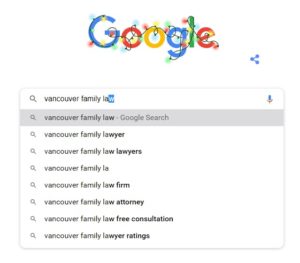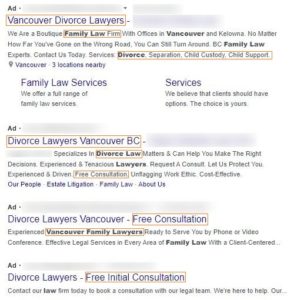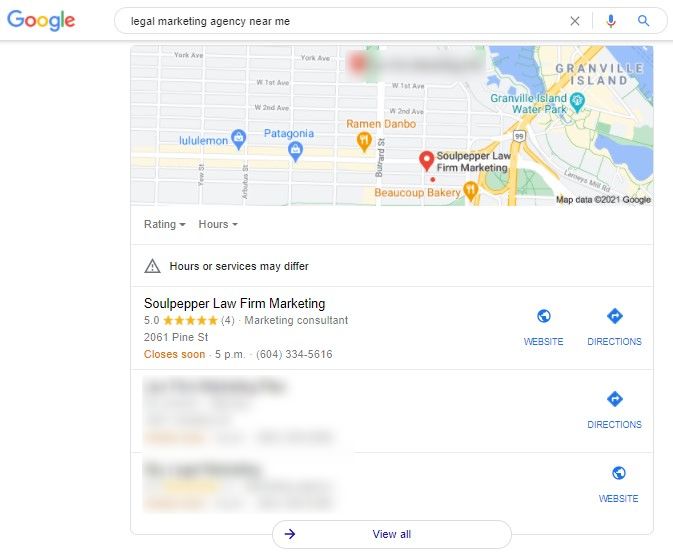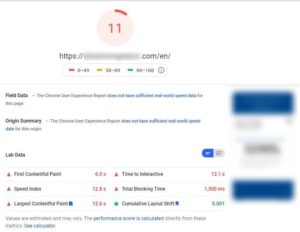If you’re interested in search engine optimization but don’t know where to start, this series is for you. We’ve compiled this article of SEO Strategies, processes, and tips to grow your law firm.
Table of Content:
Search Engine Optimization: SEO Setup Checklist
Search Engine Optimization: Keyword Research and Competitive Analysis
Search Engine Optimization: Content Strategy
Search Engine Optimization: Google My Business and Local Search
Search Engine Optimization: Link Building
Search Engine Optimization: Performance Analysis and Ongoing Process
Search Engine Optimization: SEO Setup Checklist
What is SEO?
SEO is a strategic framework that works to optimize your online presence for maximum organic visibility. It can include planning, implementing, and measuring on-site and off-site initiatives designed to improve your performance in search results. Search engine optimization strategies can help firms reach new potential clients by helping them rank high in search results related to the legal services they offer.
If this statement didn’t convince you that SEO is a game worth playing, perhaps the data will:

That’s right – if your website doesn’t rank on the first page of relevant search results, you’re missing out on a lot of potential business.
So how do you get started with SEO? Before you get to researching keywords, optimizing your website content, and writing blog posts, there is some technical setup you need to get out of the way. Without the right tools in place, you won’t be able to understand your performance and make data-driven decisions about your digital strategy.
Without further ado, here are the essential steps of SEO setup.
Start thinking about SEO in the website design and development process
In order to rank high in search results, your website has to be comprehensible to users – and to search engine crawlers. Google will not be able to properly index your website if it isn’t able to map and categorize it. This means that not just your content, but also your website structure have to be SEO-friendly.
When planning a new website or redesigning your existing site, make sure your developer works towards the following goals:
- An SEO-friendly link structure
- A responsive, mobile-friendly layout
- A page loading speed under 2 seconds
To learn more about what makes a good website structure, check out our blog post:3 Tips to Improve Your Website Structure.
Set up a Google Search Console account
Once your website is ready, you can start assembling a toolkit that will help you monitor and optimize your SEO performance. Google Search Console should be an essential part of it.
Search Console is a free webmaster tool offered by Google, designed to help site administrators monitor, maintain, and troubleshoot their website’s performance in Google Search results. You can use it to discover coverage issues, explore your visibility in branded and non-branded search results, test mobile visibility, and, in general, keep an eye on how your website is performing. Insights from Search Console should be the driving force behind tweaks and improvements to your website and content.

To set up your account, follow Google’s instructions. Heads up: the verification process requires you to add a DNS record in your domain name provider. It’s best if you bring your website developer or IT specialist into this process.
Set up a Google Analytics account
Google Analytics is another powerful tool from Google, and it also happens to be free. As the name suggests, GA is a marketing analytics tool. While Search Console collects information about how you perform in search results, Google Analytics offers you an in-depth look into your website traffic. Using the tool, you can analyze website traffic sources, visitor data, engagement metrics, conversions, and much more.

To set up your account and create basic reports, follow Google’s guides. Adding a tracking code to your website is a necessary step, so be sure to ask your developer or IT specialist for help if you’re not comfortable with making changes to the back end of your site.
Install an SEO plugin on your website
The next step you should take is installing an SEO plugin on your website. This is particularly easy if you are using WordPress – a variety of plugins are available for this popular content management system (CMS).
An SEO plugin will help you optimize your web page and improve your SERP rankings, providing you with scores and tips as you populate your CMS with content.
Some examples? A good plugin will rate your URL, metatags, keyword density, and the readability of your content and provide actionable tips for optimizing all aspects of your pages and posts. Your SEO plugin should also allow you to access and edit your robots.txt file and customize your sitemap index (don’t worry, more on sitemaps and robot files in a moment).

If your site is not built in WordPress, contact your developer to find out what tools you can use for search engine optimization.
Generate and submit a sitemap
A sitemap is, well, a map of your website in the form of a list of URLs. It helps Google (and other search engines) understand the structure of your site and decide which pages should be crawled and indexed.
If you’re using WordPress, you can easily generate a sitemap within your CMS. If that’s not the case, you can create one manually or using an external sitemap generator tool.
Not sure if you already have a sitemap? Go to your main website and add /sitemap.xml after your root URL in the address bar – that’s where you should find your sitemap.

Once you’ve created or tracked down your sitemap, submit it to Google Search Console:
- Sign in to your account
- Go to Sitemaps (select from the menu on the left side of the screen)
- Enter your sitemap URL in the ‘Add a new sitemap’ section and click ‘Submit’.

Create robots.txt file
Similar to sitemaps, robots.txt files also communicate with Google’s crawlers. These files consist of rules that block or allow crawler access to specific parts of your website.
The robots.txt file could, for example, include a link to your sitemap and information that certain parts of your site (such as contact form submission links) are off-limits for crawlers.
The easiest way to view your robots.txt file is to go to www.yourdomainname.com/robots.txt. If you need to make edits to the file or create one, you can do so in your CMS or, if you’re not using WordPress, you can manually upload a text file to the root of your domain.

Measure your site speed
Another step in setting yourself up for SEO success is making sure that your site speed is not negatively affecting your ranking in search results. Page speed has been a ranking factor for Google since 2010, and as the search engine develops, their focus on good user experience is becoming stronger. Needless to say, page speed contributes to user experience in a big way.
You can check your mobile and desktop site speed using free tools such as GTmetrix or Google’s PageSpeed Insights. Both tools present test results in a comprehensible, visual way and provide descriptions that will help you interpret where you stand.
If you find out that your site speed is too slow, ask your developer to look for fixes.
Search Engine Optimization: Keyword Research and Competitive Analysis
What is keyword research?
Keyword research is the process of identifying the keywords that your target clients are searching for online in order to focus your content strategy on them. Knowing what keywords you should be targeting, you can create relevant content that will answer your target audience’s questions, address their needs, or help them solve a problem. A consistent keyword strategy across your site will also help Google understand exactly what services your law firm offers and include your website in relevant search results.
What is competitive analysis?
Competitive analysis should supplement your keyword research. Knowing how other successful law firms address their target clientele and what keywords they focus on can point you in the right direction and save you a lot of trial and error. When running keyword and competitor research, you should aim at finding a sweet spot: keywords with a lot of potential to drive search traffic but not too much competition. For example, if your biggest competitors dominate top search results for a high-level keyword like family lawyer, you could try to pinpoint some more location- and service-specific long-tail keywords that people look for, e.g. child custody lawyer Mississauga.
4 ways to do simple keyword and competitor research
Below, you can find 4 simple exercises that will help you get a rough understanding of the list of keywords you should be targeting with your content. These methods do not require the use of specialized tools or SEO software – it’s all you!
Google suggestions
Google is the primary source you should turn to when trying to conduct free keyword research. The search engine makes the task very easy with a feature we’re all so used to, we don’t usually think of it as a potential marketing tool: Google search suggestions.

Why are the insights from Google search suggestions so valuable? Because the list is comprised of actual searches from actual real users, ranked by popularity. They vary by region and language, so you can safely assume that the suggested keywords you see are popular search terms in your area. Using them as keywords in your content strategy will help you cater to the needs of potential clients looking for legal services in your area.
Google Ads
Another great way to use Google search for keyword research is to take a close look at paid search results. Large law firms spend big advertising dollars on search engine marketing, and you can trust that the keywords used in top ads are the ones that successfully attract leads – after all, search campaigns are always backed with extensive keyword research.

Look for patterns. For example, if you notice that several of your competitors are mentioning free consultations in their search ads, consider using the phrase free consultation on your website, in your blog posts, in a few page titles, etc.
Using search ads as an inspiration for your organic content strategy is like taking a well-informed shortcut to identifying winning keywords.
Manual first page results review
This next exercise requires a bit more investigative work.
Run a Google search for the phrase that you believe best describes your services (e.g. family lawyer Toronto). Then, open the pages listed in organic results on the first page. The content you find there can serve as an inspiration for your own content strategy – if these pages perform so well in search results, their SEO strategies are clearly working. Take note of frequently used keywords, focusing on phrases used in page titles, headings, URLs, calls to action, etc. While the goal we are focusing on today is keyword research, take this opportunity to look into other aspects of your competitors’ websites. Ranking on the first page isn’t determined solely by content optimization – user experience is an important ranking signal used by Google’s algorithm.
When researching your well-performing competitors’ sites, keep an eye out for innovative design or technology solutions that could potentially also work for your firm.
Quora, Reddit, and social media
In some ways, SEO is the art of pleasing search engine algorithms. But we shouldn’t forget that these algorithms work to best match the search intent of their users. This means that if you want to excel at SEO, you have to start with building an understanding of what it is that your clientele needs and looks for on the internet.
A great way to find this out is to listen to your potential clients. Find places – online forums, social media groups – where people go to discuss their legal needs. If you find popular threads that are relevant to the profile of your firm, consider creating content that explicitly answers the questions they raise. Use the same key phrases as the participants of these online discussions to improve the chances of your content gaining traction through organic search.
Search Engine Optimization: Content Strategy
The content you publish to your website and blog is a big part of what search engines pick up and analyze when crawling the web. Well-optimized content is like a map for search engine crawlers, providing them with a clear indication of your area of expertise and the services you offer. This can effectively help your site appear in relevant search results and gain exposure to new potential clients.
Understanding the purpose of content
Content is a broad term. It applies to everything you publish on your website – pages, blog posts, images, videos, calls to action. It plays an important twofold role in helping you reach your audience online.
First of all, as already mentioned, well-optimized content can help you rank high in relevant search results. Using keywords related to your area of expertise, providing explicit answers to popular questions, clean formatting – all of this can help Google make sense of your page and suggest it to your target users in organic search results. But appealing to search engines is not enough to become successful. Your content also has to engage your website visitors, answer their questions or provide solutions to their problems, and guide them towards a conversion, e.g. booking a consultation or giving you a phone call.
You may think that this latter facet of content strategy has little to do with SEO, but that’s not true. User engagement metrics such as dwell time and bounce rate are treated by Google as ranking factors and as such, they can affect your position in organic search. That’s why in order to build a truly successful organic online presence, you need to master SEO tactics and understand your audience’s needs to create content that will address them accordingly.
Analyzing your audience
In order to make your content useful and engaging to your audience, you have to understand your target clients and their online behaviours. Knowing what your prospects look for online will help you tailor your content to their needs.
If you followed the keyword research process described in our latest SEO article, you’re already equipped to research popular organic searches and drive inspiration from competitive analysis. But there’s really no other source of client insights as valuable and reliable as… well, clients. Review your current and previous clients who found your law firm through Google. Understanding the types of legal issues the majority of your clients need help with will give you a clear idea of which of your services are the most in-demand. Focus your strategy on them to reach an even wider group of potential clients.
Your clients can also help you understand whether your existing website content is straightforward and informative enough. Perhaps a lot of your clients ask whether you offer a specific service when they first reach out? Always take note of such inquiries – if any of the content on your website is unclear or confusing to your clients, it’s not doing its job and should be reviewed and adjusted accordingly.
You can also get a better grip on the search intent that drives traffic to your website by analyzing search queries in Google Search Console – you can find more information on how to do that here.
Defining your topic area
This part of the process should be easy if you completed your homework.
Following keyword research, popular search analysis, and an audit of your client base, you should be able to create a core strategy. Here’s an example:
- you specialize in family law
- you’ve discovered that ‘divorce lawyer Mississauga’ is a relevant keyword
- you know that most of your divorce clients also require assistance with support and custody issues
Use this information as a roadmap. Create separate service pages detailing how you handle divorce, child custody, and spousal and child support cases. Then plan blog posts that will go into more detail and answer frequently asked questions about divorce, custody, and support. Consistently posting relevant content related to your areas of expertise will help Google recognize your site as an authority on the subject matter and will effectively help you move up in search rankings.
Once you have plenty of content covering services in highest demand, start branching out. Continue growing your position as an authoritative voice on everything related to divorce and family law. Let your customers know that you can also help them handle separation agreements, property division, etc. Consistency is the name of the game, and the end goal is covering every service that your firm is qualified to assist clients with.
Optimizing your content
Once you’ve created a piece of relevant and useful content that will engage your target audience, you can move on to publishing it to your website or blog. but before you hit that ‘Publish’ button, take some time to optimize your content. The steps listed below will make your content more comprehensible to both readers and Google.
- Make sure your content is easy to follow: avoid very long paragraphs, unnecessarily difficult phrasing, and passive voice
- Aim for neat formatting. Break your content up into smaller sections and use headings and subheadings to clearly indicate what each section covers (bonus points if you use relevant keywords in the headings)
- Where applicable, use numbered or bulleted lists to further improve readability
- Bold key phrases to help your readers – and search engines – follow your main point
- Link to other relevant pages or blog posts from your website (this can help users find additional information on the subject – and spend more time on your site, improving dwell time)
- Include alt-text when uploading images
- Add a clear call to action letting your readers know what steps they can take to further pursue their goal (solving their legal issue), e.g. link to your consultation request form or your firm’s phone number.
Once your content is optimized, you’re all set! Following publication, make sure to check in on how your content performs. Analyze its performance in search results as well as traffic and engagement metrics. It’s likely that not every single piece of content you publish will become wildly successful, but every piece of content can provide you with insights on how to improve your strategy moving forward.
Search Engine Optimization: Local SEO and Google My Business
As a lawyer, you should be reaching a somewhat local audience online. Perhaps not all of your clients live in the direct neighbourhood of your office, but a lot of them are likely in the same city, metropolitan area, or state as you.
What is local SEO?
Local SEO is an umbrella term for a set of best practices and strategies you can implement to improve your visibility in search results when people who are close to your physical location (potential local clients) search for phrases related to your services.
Here’s an example – optimizing for local SEO can help an LA-based law firm show up in local search results when someone in Los Angeles searches for ‘family lawyer near me’ or ‘best family lawyer in Los Angeles’.
Surfacing in such searches is particularly valuable because it places your content in front of a relevant audience with specific intentions. A person looking up legal offices in their area is likely past the point of general research and should be ready to take the next step, i.e. schedule a consultation, or at least shortlist offices they want to contact.
Who should be interested in local SEO?
Any business with a brick and mortar location or a defined service area can benefit from local SEO. Simply speaking, if you are connecting with clients anywhere else than online, you should be interested in improving your visibility in local search.
Legal services naturally attract local target clients. Legal proceedings can span over weeks or months. The convenience of working with a local law firm affects many clients’ decisions as to which law firm to pick. So naturally, law firms should be just as interested in local SEO as any other business with a physical location.
What affects local SEO?
When selecting pages to display in the SERP (search engine result page), Google uses a number of ranking factors to determine what the user should see.
Here are the key search factors that affect local SEO:
Relevance
In layman’s terms, this component of Google’s local algorithm reads your website and tries to make sense of it. If you want Google to categorize your content as relevant to searches pertaining to the area of law that you practice, make sure you’re using the right keywords across the board (in URLs, meta titles and descriptions, in the content itself) and that your website is home to a wealth of content related to your area of expertise.
Prominence
Prominence is a ranking factor that ranks your website against your competitors and tells Google how reliable your business is. You can build prominence through creating and sharing local content (e.g. articles touching on local news), being active on social media, acquiring positive reviews for your firm, and implementing a link strategy.
Proximity
Sometimes there are many relevant and prominent web pages that can be displayed on the SERP. In such cases, proximity can affect the order in which they appear. This factor is unique to local SEO.
If you do a good job optimizing your website for local visibility, you get a chance of appearing in 3 types of local searches:
- Geo-modified searches, e.g. family lawyer in Los Angeles
- Non-geo-modified searches, e.g. family lawyer
- ‘Near me’ searches, e.g. family lawyer near me
In the last two cases, proximity is determined by the user’s location and how their geographic area correlates with where your firm is located.
How to optimize for local SEO
When describing the 3 search factors that affect local SEO, I already mentioned a few strategies you can implement to improve your visibility in local search:
- Consistently using the right keywords
- Optimizing meta tags and URLs
- Publishing relevant blog posts
- Acquiring positive reviews
- Building a strong social media presence
- Promoting your page through link strategy
But there’s one strategy that can take your local SEO efforts to the next level:
Optimizing your Google My Business Listing
Google My Business is a free tool that allows businesses to create profiles on Google. Think of your Google My Business listing as your virtual business card, or a filtered version of your website.
A well-optimized GMB listing gives Google all the information the search engine needs to identify your business as local. The information from your GMB profile is used to place your pages in relevant SERPs (in the form of traditional or local pack results – see image below), in Google Maps search results, and in mobile searches.

Local Pack results
The key to optimizing your Google My Business listing is thoroughness. Make sure that you fill in all the information the form asks for, including categories, your business description, and photos. You will also want to keep your listing active by adding posts regularly and replying to client reviews.
If at this point you’re not convinced that Google My Business is worth your time, remember that its role goes beyond helping you surface in local search. Once your potential clients come across your listing, they can immediately interact with it – visit your website, give you a call, or ask for directions to your office. This boosts your chances of converting users with a shorter attention span, e.g. mobile users or potential clients looking to quickly get in touch.
Search Engine Optimization: Backlink Strategies for Lawyers
Search engine optimization is a technical area of marketing with a lot of moving parts. If you want your website to perform well in organic search (i.e. be discovered by potential clients googling legal services), you have to make sure Google sees it as a relevant and reliable source of information.
What are backlinks and why are they important?
Backlinks are inbound links – hyperlinks living on sites other than your own (third party sources) that direct traffic to your website.
For example, if you are featured as an expert in a news article published online, the editor will likely add a link to your website for readers interested in learning more about your law firm’s services. This would count as a backlink – and a good one, because news websites usually have high domain authority (I’ll go into more detail on what this means in a bit).
Research shows that a website cannot reach its full organic potential without inbound links. Links are one of the most important ranking factors that Google takes into account when compiling search result pages. They signify trust and quality (if someone is linking to your content, it means they find it link-worthy) and it is through links that Google’s crawlers discover your website.
What makes a good backlink profile?
At this point, you might be thinking that simply having many inbound links leading to your site will help you rank higher in search results. This is only partially true because not all links are equally valuable. Link building is a quality over quantity type of game.
Here are some characteristics of a good backlink. Keep these in mind when acquiring links to build a strong backlink profile for your site. This is important because risky backlinks can do more harm than good. If Google recognizes that you are trying to manipulate the algorithm, it can penalize you with a hit to your organic traffic.
Authority
Domain authority is a popular SEO metric measured on a 100-point algorithmic scale. It is used to describe a website’s relevance for a specific topic or area of interest. A website’s domain authority score reflects how strong the site’s backlink profile is and how likely it is for the site to rank in Google.
Links from domains with high authority are seen by search engines as more valuable than links from low authority sites.
Trust
Google deems certain domains more trustworthy than others. Trusted websites usually have an established organic presence and an immaculate backlink profile, and are in good standing with the search engine’s policies. Big news websites such as BBC or The Huffington Post usually have a high trust factor.
You can build your domain’s trust by acquiring links from trusted websites.
Relevancy
Relevance is another measure of link quality. While search engines consider many factors when determining relevance, simply speaking, links coming from websites at least remotely related to the law will be deemed more relevant than links coming from websites about, say, fashion.
The good news is that as a lawyer, you have an opportunity to acquire relevant links even from websites that are seemingly unrelated to your area of practice. Legal expertise comes into play across industries, and a link to your resources might be relevant even coming from a local news site or a brand’s blog.
Diversity
To perform well in organic search, you should work towards building a diverse link profile. This means that, ideally, your inbound links should come from different domains and different types of domains (e.g. blogs, websites, directories). Diversity also relates to where the link is located on a given page (body, footer, etc.) and anchor texts.
A robust and diverse backlink profile shows Google that your firm is trusted by many domains and that your content is useful and universal enough to appear in different contexts.
With all of our bases covered, we can move on to the big question.
How do you acquire backlinks for your law firm website?
Here are a few proven methods to acquire links, improve your site’s authority score, and rank higher in search results.
Create content that people will want to share
This one sounds obvious, but it’s the best way to generate links. Make sure that you share valuable resources on your website – interesting blog posts and case studies or industry-specific insights you can drive from your experience. If people find your content unique and useful, they will be inclined to share it and link back to the source.
Write press releases
I already mentioned that news sites are usually trusted by Google and have high domain authority scores. A good way to generate a mention (and a link) on a news site is to share a relevant press release with the editing team. If new laws or regulations are being introduced in your area, offer your expert commentary or make yourself available for an interview. Doing so will not only earn you links – news features will also help you build your reputation as an esteemed thought leader.
Join local business directories
Directories and review sites are usually high-authority, trusted websites that have a very specific audience of targeted, high-intent readers. Creating a profile for your law firm in relevant directories or listing sites is a great way to generate high-quality backlinks while reaching potential new clients.
Build a strong social media presence
Social media technically doesn’t directly affect your SEO. But think about your profiles as a platform for distributing your content and networking. Using social media to share content that your social following finds interesting and valuable can open up new opportunities for building links.
Summing things up, social media can support your backlink strategy by acting as a platform for:
- Outreach
- Link prospecting
- Content promotion
Remove toxic backlinks
Finally, make sure to audit your existing inbound links regularly. Links that come from irrelevant sources or sites with very low domain authority can hurt your performance, so it’s important to keep track of who is linking to your website.
Search Engine Optimization: Performance Analysis and Ongoing Process
Monitoring coverage issues in Google Search Console
On a basic level, the Coverage Report in Google Search Console tells you which pages on your site are indexed and which cannot be crawled by Google’s spiders. If Google can’t access any of your pages, it will not display them in search results, plain and simple.
Even a minor change to the back end of your website can potentially trigger a coverage issue (and affect your SEO performance), so it’s important that you check the Coverage Report on a regular basis and work with your SEO specialist or agency to resolve the problems as soon as possible.
Updating your Google My Business list
Earlier in this series, I discussed the importance of a well-optimized Google My Business listing for visibility in local search results. But simply setting up an account may not be enough if you’re looking to outperform your competitors.
Google My Business posts allow businesses to publish updates about their products, services, offers, etc. The short posts (along with an image, links, and call to action) then appear as part of the knowledge pack in local Google search results on desktop and in the Google Maps app on mobile. They are a great way to build brand awareness and address your audience before they even click through to your website. Case studies show that posting regular updates also improves visibility in local search.
Google My Business Posts are only active for 7 days. This means that if you want to include a message to your prospects or advertise a service in your GMB profile, you should post a new update every week.
Updating website content
If you want to succeed at SEO, you should treat your website as a constant work in progress. Continuously adding fresh, relevant content to your site is a necessary step to generating consistent SEO results.
The easiest way to go about this is creating a blog and frequently posting new articles. Writing content related to the area of law that you practice will help you build an image of an expert and thought leader in your field. It will also help you improve your website’s visibility in organic search results.
SEO-related benefits of blogging include:
- Staying relevant – Google wants to serve its users fresh, current, and relevant answers to their search queries. If the search engine’s algorithm recognizes that you frequently upload fresh content, it will see your website as current and relevant.
- Targeting keywords – all of your blog posts should be focused around keywords relevant to your content and representative of what your target audience searches for online. More blog posts will help you target more keywords and optimize your online presence to perfectly address your target’s search intent.
- Internal linking – every new piece of content is a new opportunity to create internal links between your blog content and service pages. Be strategic about picking the right anchor text – linking the right keywords will strengthen the connection of those keywords to your website perceived by Google.
Analyzing your performance
Last but not least – performance analysis is a key element of any successful SEO strategy. If you don’t know what results your SEO efforts are yielding, you can’t optimize for success. Check in on your performance at least once a month to identify areas of improvement and smartly allocate your resources moving forward.
To find out which metrics you should be tracking and how to decipher SEO reports, check out our short guide: How to Read SEO Reports: A Glossary.
Are you looking for law firm SEO specialists?
If you need help optimizing your website for visibility in local search, our agency is here for you. Our team of leading SEO experts will help you develop a bespoke SEO strategy and outrank competitors in Google’s local rankings.
Soulpepper Legal Marketing has helped numerous law firms of different sizes and budgets succeed, and we look forward to helping you grow your firm. Give us a call or get in touch via our contact form to see what we can do for you.



